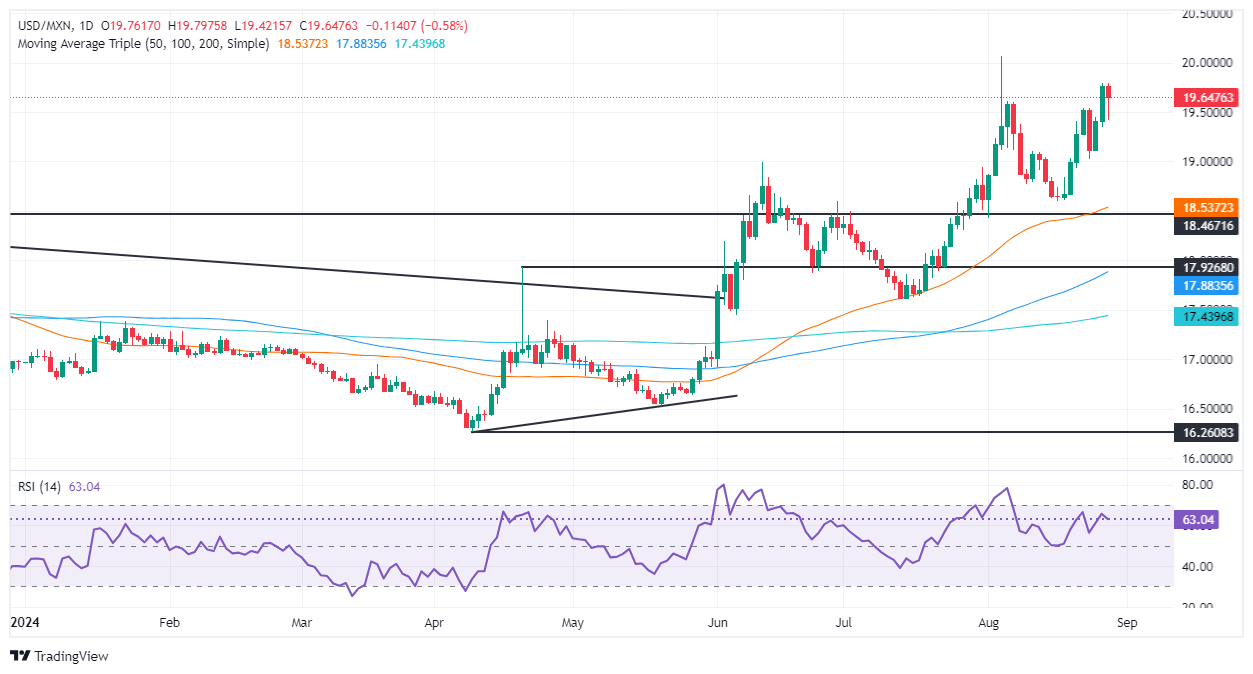- The Mexican Peso strengthens despite judicial reform and AMLO’s diplomatic “pusa” with the US and Canadian embassies.
- Focus on Banxico’s second quarter report and Fiscal Balance data this Friday amid a light economic calendar.
- USD/MXN surges near 19.80 on political concerns despite a weakened US Dollar following Powell’s dovish comments at Jackson Hole.
The Mexican Peso regained some ground against the Dollar on Wednesday, although it remains heavily influenced by political turmoil in Mexico linked to judicial reform and President Andrés Manuel López Obrador’s decision to “pause” relations with the US and Canadian embassies. At the time of writing, USD/MXN is trading at 19.64, down around 0.44%.
Mexico’s economic calendar remains absent, with traders bracing for the Bank of Mexico’s (Banxico) second-quarter report ahead of the July Fiscal Balance release on Friday. Meanwhile, Wall Street is trading at a loss as speculators await the release of Nvidia’s fiscal second-quarter 2025 earnings.
Political developments in Mexico weighed on the peso after a commission of deputies approved the ruling on judicial reform. The reform is expected to be voted on once the new Mexican Congress takes office on September 1.
This and AMLO’s pause on relations with the embassies of Mexico’s largest trading partners triggered a rally in the USD/MXN, which rose more than 1.70% and was on the verge of hitting 19.80, even though the US Dollar suffered losses against most G7 currencies after Federal Reserve (Fed) Chairman Jerome Powell hinted that rate cuts are coming in his speech at Jackson Hole.
Across the border, the US economic calendar is absent. However, traders are awaiting the publication of the second estimate of the Gross Domestic Product (GDP) for the second quarter of 2024 and the data on initial jobless claims for the week ending August 24.
Later, Atlanta Fed President Raphael Bostic will cross the news around 22:00 GMT.
Daily movements and market drivers: The Mexican peso ignores the state of risk aversion and rises
- Comments by U.S. Ambassador Ken Salazar on August 22 were the reason behind AMLO’s decision. Salazar said that judicial reform threatens the rule of law, adding that “the direct election of judges represents a great risk to the functioning of democracy in Mexico. Any judicial reform must have safeguards that ensure that the judiciary is strengthened and not subject to the corruption of politics.”
- Market sentiment remains mixed but would greatly influence the direction of USD/MXN given the safe-haven status of the US Dollar.
- Traders will be keeping an eye on Fed speakers, the release of US Q2 2024 GDP and the Fed’s preferred inflation gauge, the core Personal Consumption Expenditures (PCE) Price Index.
- Data from the Chicago Board of Trade (CBOT) suggest the Fed will cut at least 100 basis points (bps) based on the December 2024 federal funds rate futures contract.
Technical Outlook: Mexican Peso Strengthens as USD/MXN Dips Below 19.60
The USD/MXN daily chart suggests that the uptrend remains intact despite the ongoing pullback. Momentum favors buyers, as seen on the Relative Strength Index (RSI).
With further USD/MXN strength, the pair could challenge the week-to-date (WTD) high of 19.79. A break of the latter will expose 20.00, followed by the year-to-date (YTD) high at 20.22 and the psychological supply zone of 20.50.
Conversely, if USD/MXN falls below 19.50, this could expose the 19.00 figure. Further losses lie below that level, opening the door to test the August 19 low of 18.59, followed by the 50-day simple moving average (SMA) at 18.48.
Mexican Peso FAQs
The Mexican Peso is the legal currency of Mexico. The MXN is the most traded currency in Latin America and the third most traded currency in the Americas. The Mexican Peso is the first currency in the world to use the $ sign, prior to the later use of the Dollar. The Mexican Peso or MXN is divided into 100 cents.
Banxico is the Bank of Mexico, the country’s central bank. Created in 1925, it provides the national currency, the MXN, and its primary objective is to preserve its value over time. In addition, the Bank of Mexico manages the country’s international reserves, acts as a lender of last resort to the banking sector, and provides economic and financial advice to the government. Banxico uses the tools and techniques of monetary policy to achieve its objective.
When inflation is high, the value of the Mexican Peso (MXN) tends to decrease. This implies an increase in the cost of living for Mexicans, which affects their ability to invest and save. In general, inflation affects the Mexican economy because Mexico imports a significant amount of final consumer products, such as gas, fuel, food, clothing, etc., and a large amount of production inputs. On the other hand, the higher the inflation and debt, the less attractive the country is for investors.
The exchange rate between the USD and the MXN affects imports and exports between the United States and Mexico, potentially affecting demand and trade flows. The price of the Dollar against the Mexican Peso is affected by factors such as monetary policy, interest rates, the consumer price index, economic growth and some geopolitical decisions.
The exchange rate between the USD and the MXN affects imports and exports between the United States and Mexico, potentially affecting demand and trade flows. The price of the Dollar against the Mexican Peso is affected by factors such as monetary policy, interest rates, the consumer price index, economic growth and some geopolitical decisions.
Source: Fx Street
I am Joshua Winder, a senior-level journalist and editor at World Stock Market. I specialize in covering news related to the stock market and economic trends. With more than 8 years of experience in this field, I have become an expert in financial reporting.








